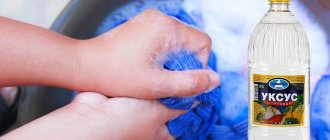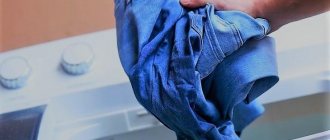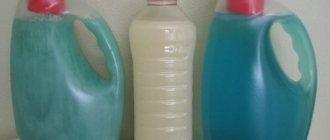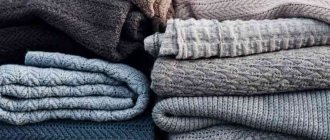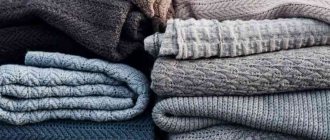Practical and beautiful artificial fabric is loved by many and is present in almost every wardrobe. The fabric is delicate and causes difficulties for housewives who do not know how to wash viscose. Things deteriorate and become deformed due to the fragility of wet fiber. The capriciousness is explained by the presence of a natural cellulose base.
Clothing and home textiles made of viscose will retain their shape and attractiveness longer if you follow washing and care rules that take into account the characteristics of the material.
Possible consequences of improper washing
- Violation of the temperature regime leads to the fact that viscose shrinks after washing. This most often happens with items that contain wool or acrylic fibers.
- Proper drying of viscose is no less important for maintaining the original condition of clothing. When you don’t have time to dry your favorite dress and have to wear it wet, there is a high probability that the product will stretch, increasing in volume by a couple of sizes.
- Viscose with the addition of polyester thread is prone to the formation of pills, spoiling the appearance of clothes. One of the reasons for their appearance is washing in a machine drum. Therefore, you need to use a laundry bag.
- For viscose items, do not use steamers or hang them on a line to dry. The material stretches from its own weight and cannot be restored.
Is it possible to iron without an iron?
You can make things look well-groomed in different ways. Even a high-quality iron can fail at the most crucial moment, so it is important to know alternative methods on how to iron things without an iron:
a bathtub filled with hot water;- moistened terry towels: lay clothes on one, straighten, cover with the other;
- boiling kettle: the item is ironed with steam;
- vinegar and water: spray the product well;
- hair dryer: clothes are moistened, smoothed, then dried;
- An iron is an ideal tool for ironing collars.
The ironing cabinet can handle any material. It will help get rid of even large creases, stretch the product after washing, and create creases in trousers. Such devices allow you to iron curtains and outerwear while hanging, eliminating the appearance of wrinkles.
How to prepare things for washing
- Start by studying the label, which indicates the temperature and washing method. For different products, care requirements may vary depending on the composition and type of fibers.
- Wash items strictly by type: light, black and colored.
- When machine washing, use a mesh bag in which the material will not rub against the walls of the drum. It will protect the fabric from snagging and pilling.
- Hooks, zippers and buttons on clothing should be fastened to avoid damaging delicate fibers.
- Wash all viscose items inside out.
- If heavily soiled, clothes should be pre-soaked. Dilute the powder or liquid preparation in a bowl of warm water (30-35°). Place the clothes there for 30-40 minutes. After this, squeeze lightly and start washing.
Washing Tips
- Viscose fabrics are sensitive to direct contact with chemicals and homemade stain removers such as vinegar, ammonia, and baking soda.
- Viscose knitwear is recommended to be washed in soft water. A few drops of ammonia, which is thoroughly mixed beforehand, will help soften it additionally.
- Water with the addition of a spoonful of vinegar can refresh the color and make the fabric smoother.
- White viscose items do not fade, but are prone to staining from sunlight. This is another argument not to dry clothes in the sun. If stains have already appeared, hydrogen peroxide or oxygen bleach containing sodium hypochlorite will help remove them.
- There is no need to remove stains on viscose fabric with soap and vigorous rubbing. This deteriorates the fiber structure.
- Choose detergents that do not contain alkali or chlorine, which destroy viscose.
Is it possible?
Viscose is produced by processing natural cellulose . The fabric itself is not wrinkle-resistant, and when wet it also loses strength.
Industrial additional processing of the material significantly reduces such manifestations, but does not eliminate them completely.
Viscose can be included in mixed fabrics. Most items made from viscose are lightweight, wearable, and require regular washing. If not handled correctly, they are easily deformed. And when washed in hot water, they shrink.
Subtleties of hand washing
Washing viscose by hand is not difficult at all if you follow the recommendations.
You should start with soaking. Prepare water t=30-35° with washing or suitable detergent. Hot water negatively affects the structure of the fabric and it shrinks. Immerse the items in the soapy solution, then gently wrinkle and iron the fabric. Avoid rough impact, do not rub, twist or squeeze into a ball. Wet viscose fibers are very fragile and vulnerable. They are highly prone to deformation. Shaking will help remove excess water.
How to machine wash
You shouldn’t deny yourself the pleasure of wearing viscose clothes if you don’t have the opportunity or desire to wash them by hand. A washing machine will successfully cope with this task; you just need to be properly prepared and know how to wash viscose in a washing machine.
- Items should be washed in the drum separately from items made from coarser fabrics.
- Load the clothes into the drum, placing them in the wash bag.
- Turn on the “Manual” or “Delicate” mode on the panel, set the temperature to 30°.
- Automatic spinning in a drum for viscose is contraindicated, so it must be turned off.
- Place liquid detergent or a capsule for washing delicate fabrics in the special compartment. They protect the fibers and reduce friction against the drum walls.
- If there is local contamination, you should add an oxygen stain remover, and for light-colored fabrics, chlorine-free bleach.
- When rinsing, it is recommended to use fabric softener.
How to properly iron a dress made of wool, soft, viscose, polyester, silk, or knitwear?
Ironing Features:
- The most unpretentious items are made from cotton fabric. But lately, dresses are rarely made from it. This kind of fabric is mainly used for sewing linen, towels or tablecloths. You need to iron at a fairly high temperature, after moistening it.
- There are a number of fabrics that should not be ironed with steam or through a damp cloth. Viscose dresses are in fashion now. Various outfits are made from it, decorated with beads and rhinestones. Please note that viscose products cannot be ironed when damp. They should definitely be put in order only when the item is dry. It is best to iron from the reverse side, as marks and shiny spots may remain on the front side.
- When ironing silk products, it is advisable to use moisture. Remember that it is highly undesirable to use a spray bottle, because all droplets of water that fall on the fabric may be visible after drying. Therefore, the best option is to use a damp towel or cloth. To do this, lay the dress on a damp cloth and cover it on top. Let it sit for several minutes, then iron. In this case, the iron should be warm, not hot.
- Particular attention should be paid to woolen products. They are demanding and quite capricious. They should not be ironed through a damp cloth, as this may cause stretching. If the fabric becomes a little wrinkled during washing, then it is necessary to moisten the wool, stretch it to the required size and iron it with a warm iron from the wrong side. It is best to use the help of a friend so that he can stretch things while you work with the iron.
- Soft dresses wrinkle very quickly, but are easy to iron. There is no need to moisten such products, because with medium heating almost all folds are smoothed out. It is advisable to iron this kind of product from the wrong side, because stripes may remain on the front of the dress.
- Polyester clothing can also be ironed on the reverse side with a warm iron. It is advisable not to expose such fabric to moisture. If folds or significant creases have formed, it is best to steam using a steam cleaner or steam iron.
Features of ironing different fabrics
Why does viscose deform and how to correct the situation?
Viscose fabrics mixed with other fibers are most susceptible to deformation. Shrinkage is more often observed in low quality products. Natural viscose is durable and serves as a strengthening additive for wool, acrylic, and polyester.
Mistakes that spoil viscose products:
- High temperature exposure and sudden change.
- The use of powders with alkali and aggressive components.
- High-speed spin in a washing machine.
- Strong friction of contaminated areas and twisting.
- Drying near heat sources.
What to do when shrinking
If you wash viscose so that it does not shrink and the size of the item noticeably decreases after washing, then you can try to correct the situation. You should start by simply pulling out the damp item, spread out on the surface. in case of shortening, wet the shirt or dress and hang it on hangers. While suspended, try to stretch it lengthwise.
If this is not enough, then wet the clothes and let the water drain. Put on damp and wear until completely dry. Hot steam while simultaneously pulling with your hands will help to stretch the product.
If the clothes are stretched
When mixing viscose fibers with wool and cotton, the products, on the contrary, stretch after washing. The following techniques will help you reduce the size, which should be chosen taking into account the exact composition of the fabric.
- Combination of viscose and cotton
Cotton is not susceptible to warping, but sometimes it still happens. Washing in hotter water than indicated on the tag, with a spin cycle at medium speed, will help restore the shape. At the end, the products are immersed in hot water with air conditioning for 10 minutes. Dry using a dryer, or spread out on a warm surface.
- With synthetic additives
Clothes are washed with high water heat and spun at maximum speed. Then they are immersed in ice water for a couple of hours. At the end of soaking, carefully squeeze and dry.
- With an admixture of wool fibers
Wool threads are highly susceptible to stretching. To reduce an item by a couple of sizes, wash it at t=+50-60°. The spin is set to the pointer position above 500 rpm. After removing from the machine, wash with cold water and dry flat on a warm, horizontal surface.
What if viscose clothes shrink?
If a viscose item shrinks, it means that you missed something during the washing process or did not follow the recommendations for caring for this delicate fabric. Do not despair. There are several techniques to help return clothes to their original size:
- Put the wet product on yourself and walk around the apartment in it until it dries completely. In most cases, the clothing will then return to its original size.
- An iron with a steam generator will help return the product to its original shape. To do this, you need to iron the item from the wrong side, carefully stretching the length of the item and its sleeves.
- Soak shrunken clothes in warm water, gently squeeze out the water and hang on a hanger. Carefully stretch the product in length, do the same with the sleeves. Instead of a hanger, you can use a flat dryer on an absorbent backing.
Attention: the product should be stretched with caution, avoiding severe deformation.
We hope that our tips on how to wash, dry and iron viscose will help you care for this delicate fabric, and your favorite wardrobe items will last a long time without losing their attractive appearance.
Rules for drying viscose clothes
- Place washed items on wooden or plastic hangers to drain. You shouldn't take metal ones - they leave traces.
- You can lay out and smooth the product on a plane, so it will definitely not be deformed.
- A towel or folded sheet will help remove excess moisture. The blouse is placed on a towel and rolled up, pressing lightly. This way, deformation will be avoided.
- Heated dryers and washer dryers cannot be used. As well as drying wet things on radiators or the active sun. Exposure of viscose to high temperatures causes deformation and shrinkage.
- To dry, items with a high content of viscose fiber should be smoothed by hand on a flat surface.
Types of ironing
There are three types of ironing:
- Dry. When things are ironed on the front or back side with a hot iron
- With hydration. With this method, the fabric is saturated with water using a sprayer. Or a damp cloth is placed on the clothes
- With steaming. In this case, water is poured into the iron and the steam mode is turned on.
The method is selected depending on the characteristics of the fabrics and the conditions indicated on the tag. Please note that there are a lot of fabrics that are quite difficult to iron. In this case, you can use these tips.
Chiffon dress
It is prohibited to dry viscose in a washing machine. Also, do not hang products on heating devices or in the open sun.
The best choice for fabric is to choose a horizontal arrangement. To do this, spread a terry towel on a flat surface, and place a wet item on top of it. At this stage, it is important to straighten the product well so that there are no creases left on it.
You can speed up the drying process by placing another terry towel on top of the item of clothing. Gently press it with your palms so that excess moisture is absorbed into the towel. After this, it is removed, allowing the viscose to dry further.
During the ironing process, you must act very carefully so as not to spoil the item. Viscose should be ironed according to the following principles:
- at minimum heating temperature;
- from the wrong side;
- through additional fabric.
If not all wrinkled areas can be straightened out, the material needs to be moistened. Viscose cannot be steamed.
How to iron viscose fabric
Iron any item of clothing or home textiles made from natural cellulose according to the following recommendations.
- The operation should be carried out exclusively from the wrong side.
- Turn the iron on low heat.
- Iron elements and decor on the front side through gauze.
- Do not use a steamer or topical humidification from a spray bottle. Hot steam causes clothes to stretch.
- If moisturizing is necessary, use damp gauze and iron through it.
How to iron a viscose dress: main steps
First of all, prepare your work area. If you plan to iron with an iron, take care of a board or hard surface. If you have complex decorative elements, it is recommended to use a steamer - for example, MIE Compatto NEW, equipped with an ironing board, where the steam iron can be used as a full-fledged iron.
Select the desired iron temperature or set the switch to “silk” mode - this way you will preserve the texture of the fabric. It’s better not to linger in one place: stroke with quick, confident movements.
Main processing steps:
- turn the dress inside out;
- moisten the gauze with water and place it on the cloth. You can use a spray bottle with clean water;
- quickly iron the surface with an iron.
Ironing the dress begins from the top - first the bodice, then the collar and sleeves. The back is ironed starting from the top and going down to the waist. After this, iron the skirt by pulling it onto the board. If the hem is narrow, you can simply fold it in half.
You can steam slightly damp clothes by hanging the dress on a hanger. To do this, use vertical steamers with a telescopic stand and iron.
Don't think this fabric doesn't need to be ironed. The last stage of caring for it consists of ironing.
We suggest you read: How long does it take for bed bug bites to appear?
This material wrinkles after washing, so you will have to iron it anyway. The main thing is to do this with an iron heated to 150° (silk mode).
Viscose should be ironed slightly damp or done through wet gauze.
And lastly, do not forget that the product should be ironed from the wrong side.
